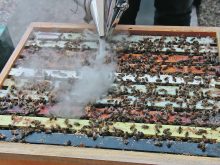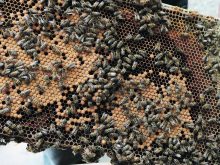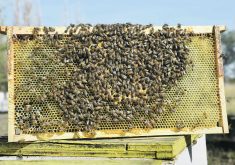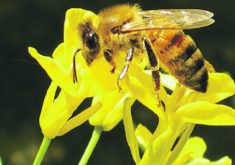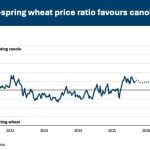Researchers have determined that the tiny spines on sunflower pollen grains significantly reduce parasite infection
The global sunflower seed market is rapidly growing, expected to expand from US$31.2 billion today to $70.6 billion by 2030.
Sunflowers, along with more than 180,000 different plant species and more than 1,200 crops, rely on insect pollinators that contribute more than $200 billion in annual ecosystem services globally. At the dinner table, one-third of our food is thanks to the role of pollinating insects.
But in recent years, pollinators have suffered declines because of the adversities of pathogens, pesticides, the ravages of the varroa mite, habitat loss, environmental contaminants, climate change and disruptions in seasonal availability of pollen and nectar. Globally, scientists have been researching ways to stop the losses.
Read Also

Farmers urged to be grain-safe this fall
Working around grain bins comes with risk, from farmers falling to drowning in grain: Experts have five tips to help avoid grain-related accidents this harvest.
A huge advance occurred when researchers discovered certain flowers help pollinators resist diseases and that the sunflower is especially effective at combatting the widespread pathogen, Crithidia bombi, which lives in a bee’s gut. But no one knew exactly why.
Now, scientists at the University of Massachusetts, Amherst, working with the common eastern bumble bee, have discovered that the secret to the sunflower’s protective ability lies in the tiny spines on the outer shells of pollen grains. Their research showed that the microscopic spines not only reduce infection of the parasite by 81 to 94 percent but, in a parallel study, they found that, as infection decreases, queen bee production increases by 30 percent.
“Previous work showed that sunflower pollen has a strong medicinal effect for common eastern bumble bees infected with the gut pathogen C. bombi,” said Laura Figueroa, assistant professor of environmental conservation. “We wanted to figure out what enabled sunflower to have this effect. Sunflower pollen’s physical structure is very spiny compared to the surface of most pollen grains, which are fairly smooth, and it contains a broad diversity of chemicals. We wanted to understand if it was the pollen’s spiny structure, its chemistry, or both, that yielded the medicinal effect.”
Just how this spiny pollen evolved to have a therapeutic effect is likely a complex relationship between the sunflower’s production of pollen and its need for help by insects to advance its reproduction.
“Plants are walking a fine line,” said Figueroa.
“They need to attract pollinators to move their pollen but don’t want the pollinators to eat it all. This leads to interesting evolutionary dynamics between bees and plants that are more complex than just bees and flowers helping one another. Spiny pollen is likely a defence against pollinivores as it makes the pollen harder to digest. That this pollen is medicinal is likely a byproduct and not a co-evolved relationship between bees and plants.”
Figueroa and her team devised an experiment based on separating the pollen’s spiny outer shell from the chemical metabolites in the pollen’s core. They mixed the separated shell into the pollen, which was fed to one batch of bees. A second batch of bees was fed wildflower pollen sprinkled with sunflower metabolites but no pollen shells.
“Our collaborator, Hauke Koch, who was working at Kew Gardens (United Kingdom) at the time, separated the outer shell from the metabolites using a series of chemical washes. Luckily, this wasn’t done at the individual pollen grain scale but in batches of 50 to 100 grams, which was much more manageable.”
The team housed the bees in individual plastic 16 ounce (453.5 grams) deli cups with mesh bottoms and perforated lids for air circulation.
“They were fed a sugar solution and pollen, which we replaced every other day,” she said. “Given that bees are often very picky eaters, we mixed the treatment of ‘just shells’ and ‘just metabolites’ in a wildflower pollen mix that is more palatable for them to eat it.”
They measured the bees’ consumption and found that how much the bees ate did not fully explain their infection levels. This showed that their results were not a product of the bees simply not eating certain diet treatments.
“We discovered that the bees that ate the spiny sunflower pollen shells had the same response as bees feeding on whole sunflower pollen,” she said. “They experienced 87 percent lower infections from C. bombi than bees feeding on just the sunflower metabolites.”
They also discovered that bees fed pollen from ragweed, cocklebur, dandelion and dog fennel, all members of the sunflower family and with similar spiny pollen shells, had low rates of the pathogen infection similar to the bees eating sunflower pollen.
“Finding that sunflower pollen spines were driving the medicinal effect led us to wonder whether other species in the sunflower family (all with spines but different lengths) could have similar antipathogenic properties. We screened the pollen from seven additional sunflower relatives, finding that four of them also reduced C. bombi infections in common eastern bumble bees. Not all the sunflower relatives tested had the antipathogenic effect, so there are other factors that matter too.”
They measured the spine length of each of the species but this did not yield a significant effect. However, their sample size was tiny compared to the entire diversity in the sunflower family. Future research may include screening the antipathogenic potential of more distantly related sunflower relatives, as well as screening species from other plant families with spiny pollen.
In addition to the discovery of pollen spines reducing infection, colleagues found that sunflower abundance was associated with greater queen production.
Colony queens are not born. They are grown by nurse bees feeding selected female larvae a diet of royal jelly that stimulates their reproductive system. A colony’s health is determined by the number of queens it produces.
To test the relationship between sunflowers and colony health, Lynn Adler, professor of biology, and Rosemary Malfi, who completed the research on bee queens as part of her postdoctoral work, placed commercial colonies of bumble bees on 20 farms growing sunflowers in western Massachusetts. Over several weeks, the team sampled the pathogens collecting in the bees’ guts, weighed the colonies to see if they were thriving, and counted the number of daughter queens.
“We needed to look at the community level as well as what’s happening in bees’ guts to know how to help them respond to stressful environments,” said Adler. “It’s exciting to show that sunflower not only reduces disease but positively affects reproduction.”
While the mechanism that leads to more queens requires more research, a theory is that reducing infection by eating spiny pollen allows bees more energy to forage more effectively and live longer at a time when queens are being developed.
Figueroa said that the role of spiny pollen may be effective because the spines scrape off the pathogens or the spiny grains do something to the gut lining that makes it harder for pathogens to stay attached.
Most plant medicines used by animals are chemical but there are examples of physical structures. Great apes infected with gut parasites consume bristly leaves that irritate their gut, which helps expel the pathogens. Figueroa’s research provides evidence that the physical structure of sunflower pollen reduces infection in bumble bees.
The value of sunflowers is highly appreciated by local farmers.
“Many allow us to conduct research on their farms to figure out what the potential benefits, and possible tradeoffs, to planting sunflowers at field-realistic levels actually are,” said Figueroa. “In the diverse agricultural matrix of western Massachusetts, it seems that having sunflowers in the mix is definitely beneficial, but we want to do more work to understand what this impact is on farmers whose operations are in different regions and vary in scale and what the impacts are for other bee species.”
Going forward, Figueroa’s team will evaluate how sunflower pollen’s antipathogenic effects scale from the molecular level to the landscape level.
“We want to know how the planting of different proportions of sunflower-family relatives in pollinator habitat influences their health, including bee disease dynamics in multiple bee species,” she said. “In five years, we hope to have a more complete picture and more specific recommendations about what to plant for the health of bees.”
Figueroa’s research was published in Functional Ecology. Alder and Malfi’s work on queen production was published in Proceedings of the Royal Society B: Biological Sciences.





